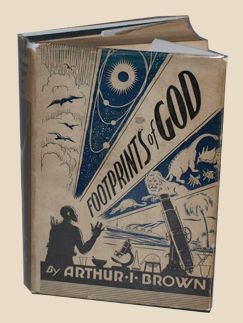
A generous member of NCSE recently offered to buy a few books from his local used and rare bookstore for us. Looking through the on-line catalogue of the bookstore, I spotted a couple of titles by the creationist Arthur I. Brown (1875–1947) that weren’t in our library (not even in The Antievolution Works of Arthur I. Brown, a reprint volume that Ronald Numbers edited in 1995): namely Footprints of God (1943)—the dust jacket illustration of which I just love—and Must Young People Believe in Evolution? (1937), the answer to which turns out, in Brown’s opinion, to be no. Brown modestly described himself as “one of the best informed scientists on the American continent.” Be that as it may, thanks to his medical degree, he at least “undoubtedly ranked among the top three or four scientific critics of evolution in the fundamentalism community,” as Numbers says in his introduction to the reprint volume. After taking a leave from his medical practice in 1925 to lecture on science and the Bible, he never returned to it.
Prompted, then, by receiving those two books of Brown’s, I’ve been skimming through his work in my spare time. Evolution and the Bible (1922), one of his first antievolution works, is choppy and derivative, and probably not tremendously influential, since it was published in Vancouver (where Brown, born in the United States, practiced surgery after completing his medical education in Edinburgh). But it’s not without interest. I was particularly intrigued by the following:
A scathing indictment of this scientific falsehood, this “nightmare of waste and death,” as Samuel Butler called it, “as baseless as it is repulsive,” is found in the American preface to “The Glass of Fashion,” a brilliant book, very recently published, from the arresting pen of “A Gentleman with a Duster,” author of those almost universally read, and vivid pen pictures, “Mirrors of Downing Street,” and “Mirrors of Washington.”
Well, golly. There was indeed a book called The Glass of Fashion, published in the United States in 1921, and the author was indeed listed as “A Gentleman with a Duster.” A little judicious internet searching reveals that it was the pseudonym of Edward Harold Begbie (1871–1929), a prolific journalist of the day: the “duster” of the pseudonym is not (to my disappointment) a long spaghetti-Western-style coat, but a wipe used to clean the mirrors of his subjects so that they can perceive themselves accurately.
And Begbie was indeed scathing about Darwinism in the preface to the American edition. Explicitly addressing his American readers and seeking their country’s “moral comradeship,” he complained of “the dark and disfiguring shadow of Darwinism”: “If we would live we must overthrow the false science which is destroying us.” He continues, “Darwinism not only justifies the sensualist at the trough and Fashion at her glass; it justifies Prussianism at the cannon, and Bolshevism at the prison-door.” (Whatever “Darwinism” is supposed to be, it is undoubtedly versatile!) Complaining of the demoralizing influence of Darwinism, he concludes, “On these grounds alone Darwinism is condemned; but it is condemned also on scientific grounds. Darwinism explains only the least interesting changes and modifications in physical structure: it does not explain the movement of life or its manifest direction towards excellence; and as to origins, and as to the final destination of all this vast and orderly movement of life, it is dumb.”
Brown quotes all that, and more, from the introduction of Begbie’s book toward the end of his own book: in fact, only one paragraph follows it. (That paragraph is headed “Shall We Bow to Baal?”—the answer turns out to be no.) He doesn’t provide any comment about the lengthy passages he quotes from the American introduction to The Glass of Fashion or—unsurprisingly, given the pseudonym—about the qualifications of its author to opine on the moral effects or scientific grounds of Darwinism. In the obituary for Begbie in the October 9, 1929, issue of The New York Times, his publisher Charles Boon was reported to have said that the identity of the Gentleman with the Duster was “one of the most closely guarded secrets in the publishing world,” which Begbie revealed only to “his closest friends, who were sworn to secrecy.” So Brown might be excused for not realizing that Begbie had no relevant scientific education—he attended Merchant Taylors’ School in London, leaving in 1891, nine years before it added a course in biology.
By the same token, Brown might be excused for not realizing that Begbie was already on record as accepting evolution. In The Proof of God (1914)—published under his own name—Begbie argues, through a fictional dialogue with his atheist friend Rupert, that religion and modern science are mutually reinforcing. In chapter two, “On Evolution,” he tells Rupert, “The elements were assembled, tiny cells resulted, Life began. And from these humble forms, evolution build up structures so wonderful and so beautiful as the bodies of the gazelle, the thrush, the tiger, the bee, and Man.” God is responsible for evolution: “Evolution is obviously an orderly process, a method which has the impress of a very high intelligence.” Darwin is mentioned, respectfully, as giving “new vision to religion,” although it’s suggested that he inspired “a few scatter-brained ‘rationalists’” to atheism; Darwinism is not mentioned; natural selection is mentioned, dismissively but without hostility, only twice. But is Brown off the hook? Not quite, as I argue in part 2.

